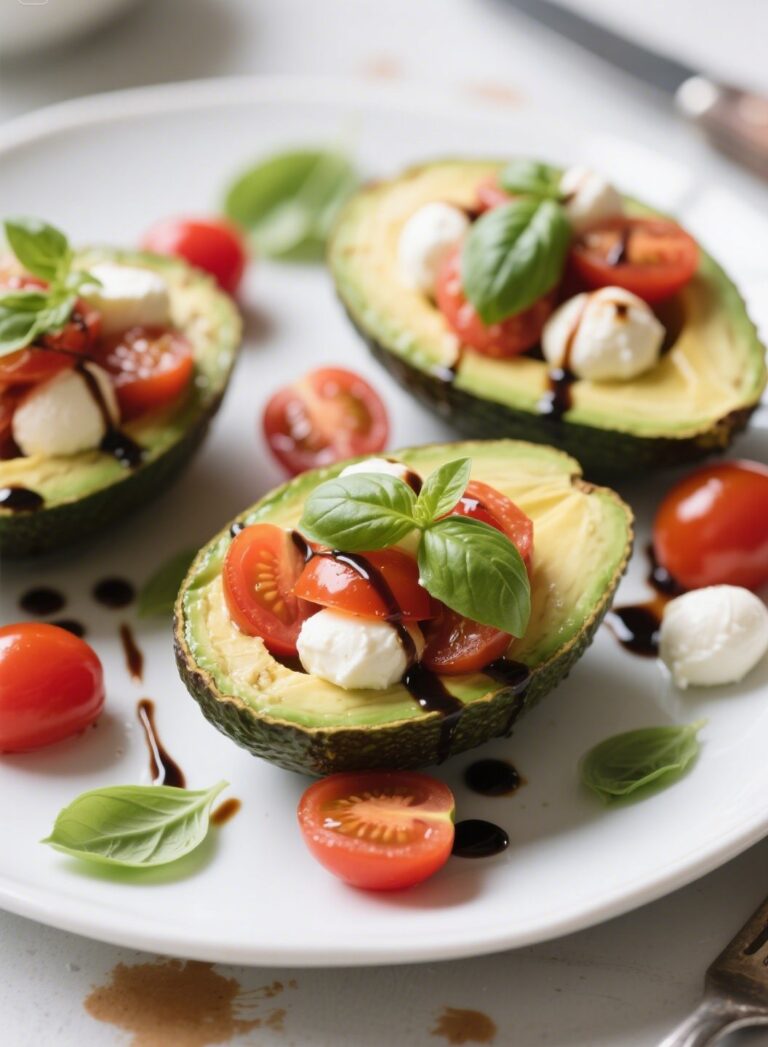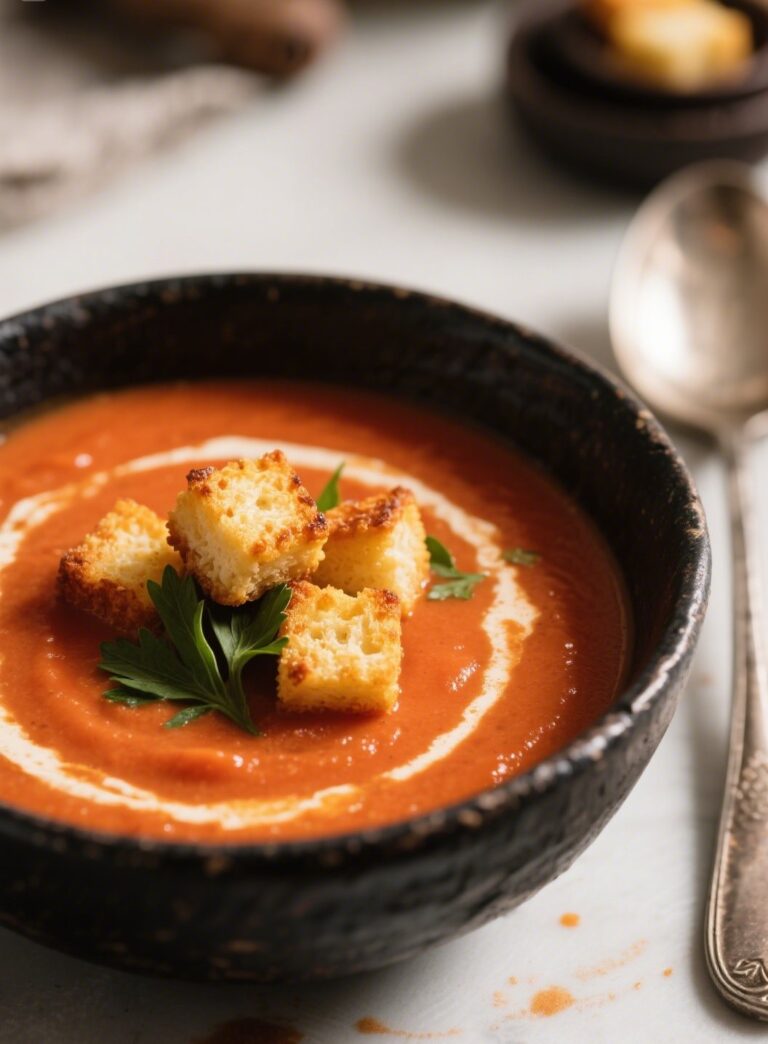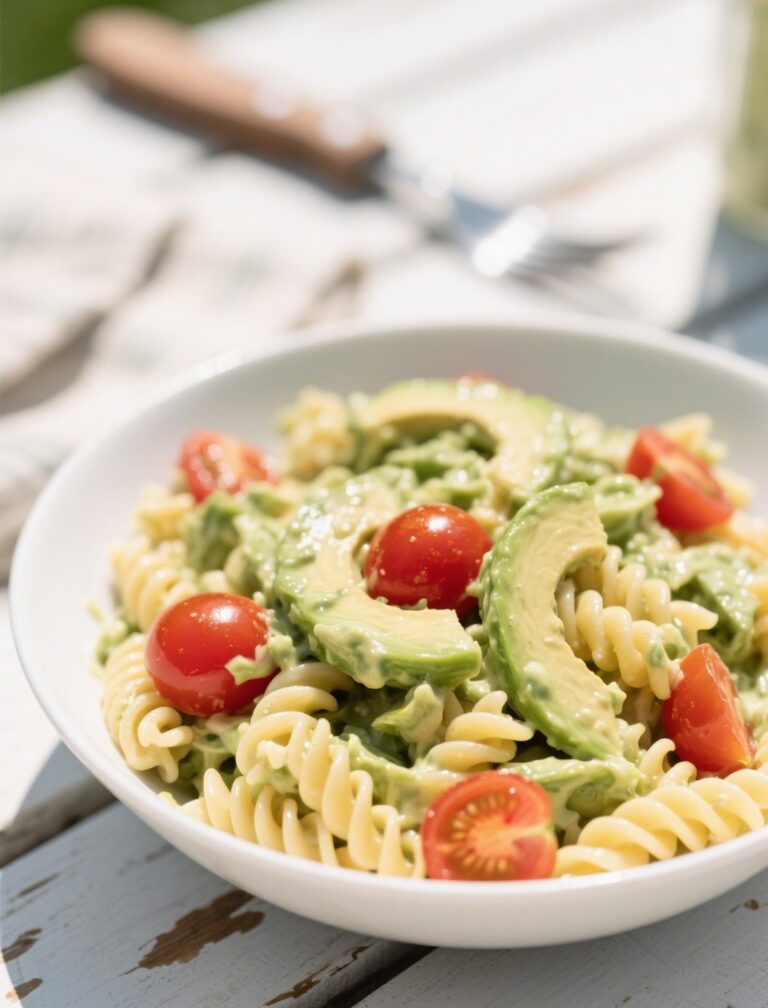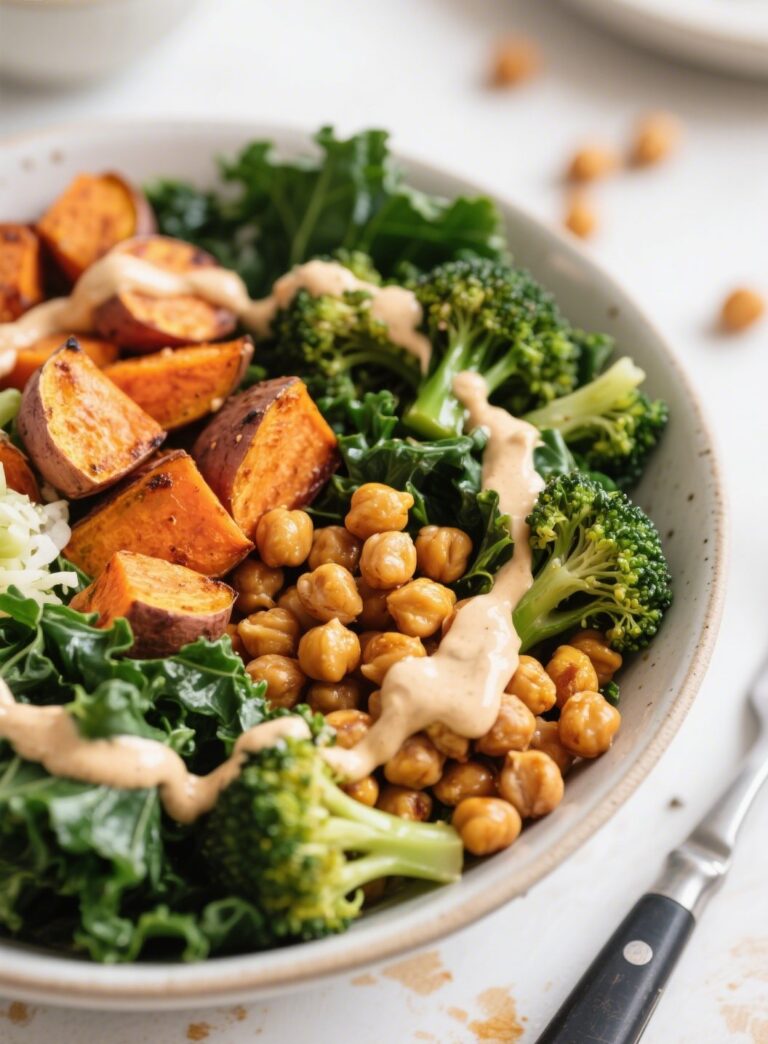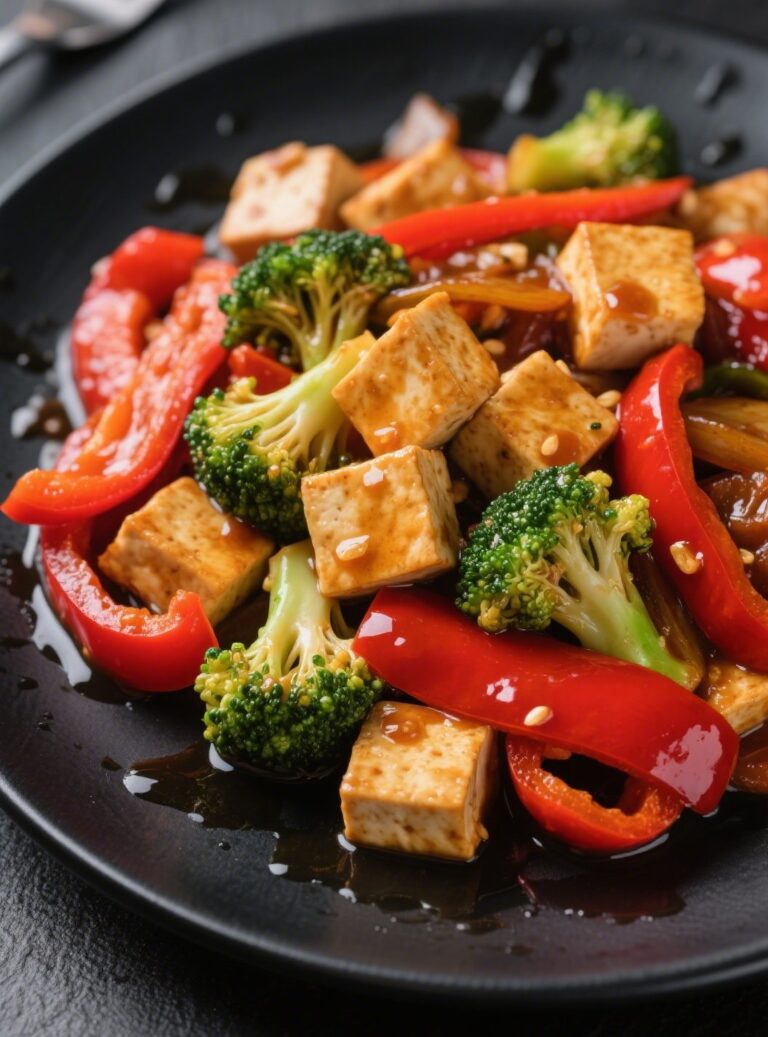Chickpea Spinach Curry – The Best One-Pot Comfort Recipe Packed With Flavor
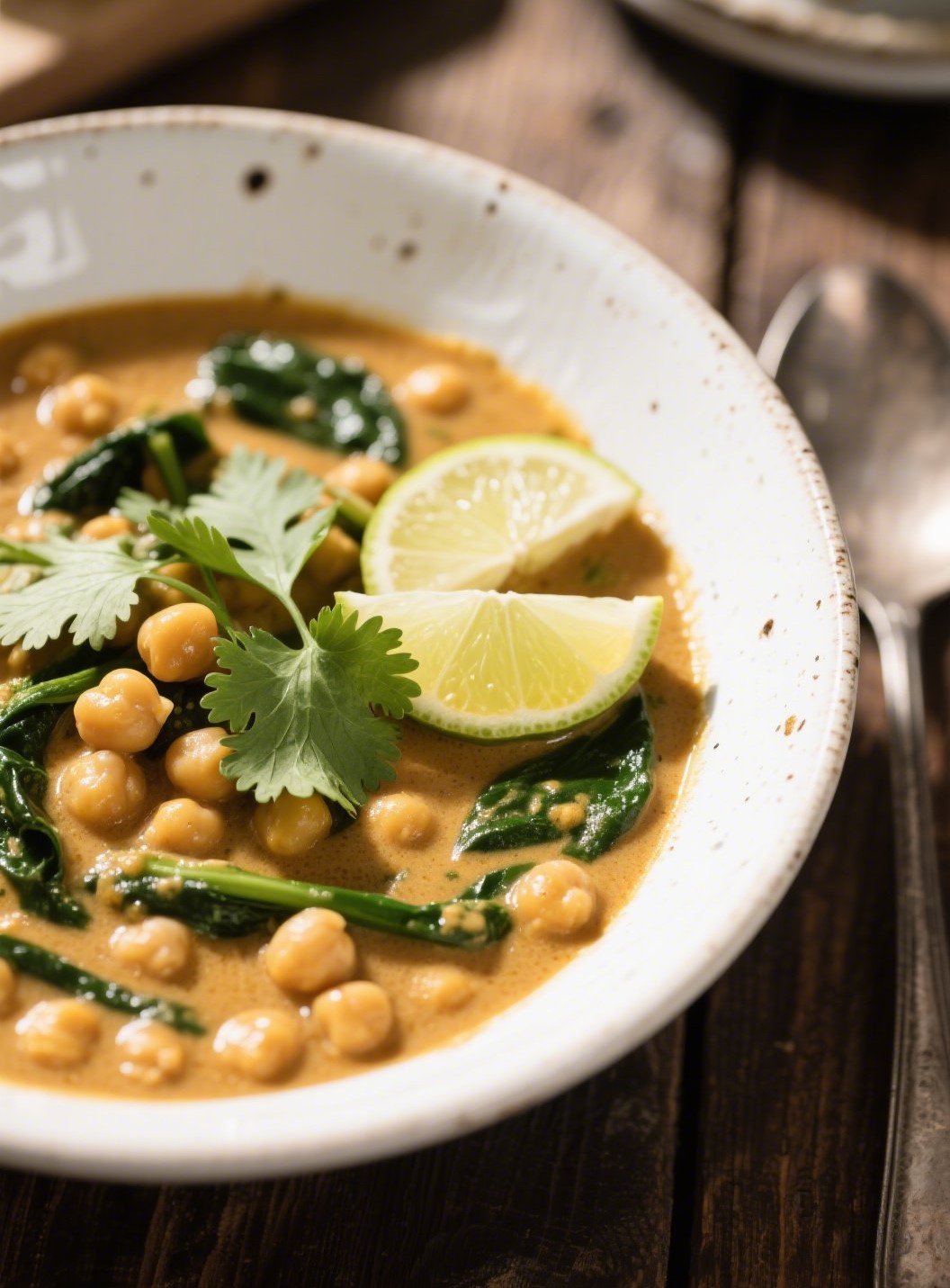
Looking for a hearty, healthy, and hassle-free dinner? This chickpea spinach curry brings everything to the table—flavor, nutrition, and simplicity in one comforting bowl. Whether you’re meal prepping for the week or whipping up a quick weeknight dinner, this dish is packed with protein-rich chickpeas, antioxidant-loaded spinach, and a creamy coconut base that’ll make you forget you’re eating healthy. Plus, it’s entirely customizable and ideal for vegans and vegetarians alike.
Check out vegetarian buddha bowl with tahini dressing for another nutritious plant-based meal.
In this article, we’ll explore step-by-step instructions, ingredient benefits, customization tips, and answers to popular questions. Whether you’re new to plant-based cooking or a seasoned curry lover, this guide has everything you need to create the best chickpea spinach curry you’ve ever had.
Introduction to Chickpea Spinach Curry
What Makes Chickpea Spinach Curry So Popular?
Chickpea spinach curry has quickly become a go-to comfort meal, especially among health-conscious foodies. But what exactly makes it so well-loved?
For starters, it’s a one-pot dish that takes minimal time to prepare. The combination of earthy chickpeas, tender spinach, and rich coconut milk creates a layered depth of flavor that’s both savory and slightly sweet. The use of spices like turmeric, garam masala, and coriander adds warmth and complexity, while still being easy on the spice tolerance for most palates.
And let’s not forget: this curry is vegan-friendly, gluten-free, and extremely cost-effective. It’s a rare trifecta of healthy, tasty, and affordable cooking that makes it suitable for families, students, and busy professionals alike.
Why It’s the Perfect Weeknight Meal
When you’re short on time but still crave a wholesome meal, this curry delivers. It uses pantry staples—like canned chickpeas, crushed tomatoes, and coconut milk—so you likely already have most of the ingredients at home.
Cooking this Chickpea Spinach Curry is as simple as sautéing, simmering, and serving. You don’t need any fancy equipment or advanced techniques. Plus, it’s incredibly forgiving. Even if you eyeball the spices or use frozen spinach instead of fresh, the dish still turns out flavorful.
Beyond the ease, it’s a great make-ahead recipe. It stores well, tastes even better the next day, and reheats beautifully. That makes it ideal for meal preppers who want healthy, ready-to-eat meals throughout the week.
Ingredients Overview and Their Nutritional Value
Essential Ingredients in Chickpea Spinach Curry
Every good curry starts with a base of bold flavors and simple ingredients. Here’s a breakdown of what you’ll need for this chickpea spinach curry, with tips on selecting the best options for taste and nutrition:
| Ingredient | Purpose | Tips |
|---|---|---|
| Olive Oil | Base for sautéing onions and spices | Use extra virgin for richer flavor |
| Onion | Adds sweetness and depth | Yellow or white onions work best |
| Garlic | Boosts aroma and complexity | Freshly crushed cloves preferred |
| Garam Masala | Signature spice blend | Store-bought or homemade |
| Coriander & Turmeric | Warm, earthy notes with anti-inflammatory benefits | Toast slightly for deeper flavor |
| Crushed Tomatoes | Tangy base with natural sweetness | Use canned with no added salt |
| Coconut Milk | Creamy richness and subtle sweetness | Full-fat for best consistency |
| Chickpeas | Protein and fiber source | Canned chickpeas are quick and easy |
| Vegetable Broth | Enhances flavor and consistency | Choose low-sodium to control saltiness |
| Baby Spinach | Nutrient-dense and fast-cooking | Use fresh, tightly packed leaves |
This ingredient list not only ensures a flavorful curry but also provides a solid foundation for a plant-based, nutrient-rich meal that supports energy, digestion, and immunity.
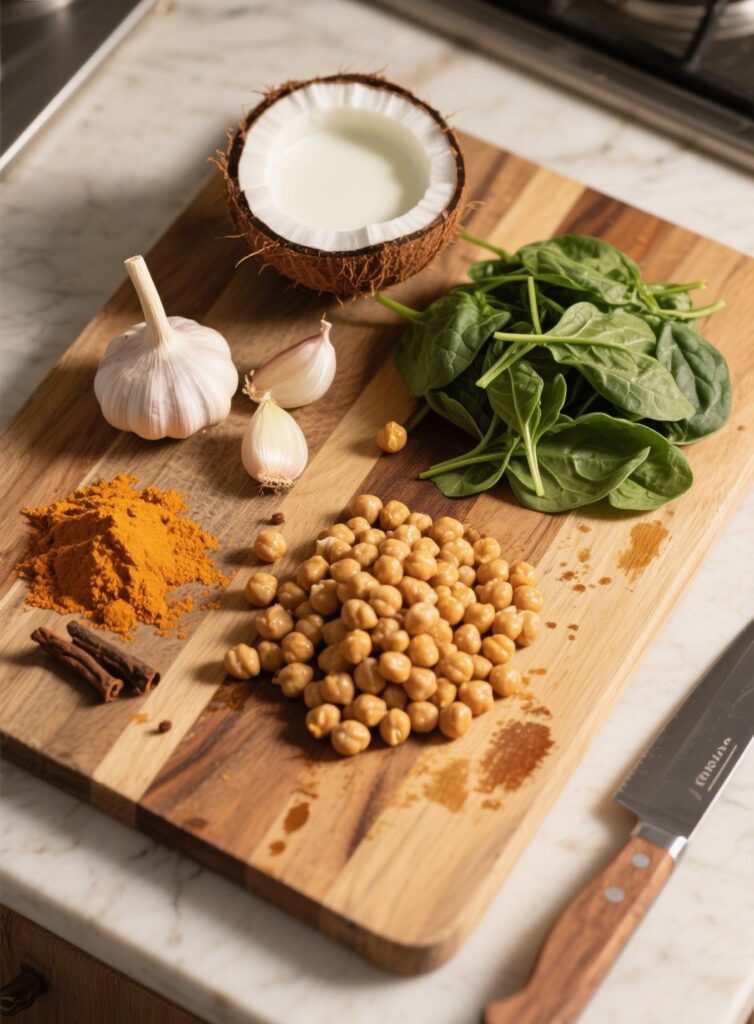
Health Benefits of Chickpeas, Spinach, and Coconut Milk
What makes this chickpea spinach curry more than just a comfort meal is its impressive nutritional profile. Let’s take a closer look:
Chickpeas: A Plant-Powered Protein Boost
Chickpeas are rich in plant-based protein and dietary fiber, making them ideal for vegetarians and vegans. They help keep you full longer and aid in blood sugar regulation.
Spinach: Loaded with Micronutrients
Spinach is high in iron, vitamin C, and magnesium. It’s also low in calories but high in antioxidants like beta-carotene and lutein, which support eye health and reduce inflammation.
Coconut Milk: Healthy Fats for Creaminess
Full-fat coconut milk adds a creamy texture while supplying healthy fats (medium-chain triglycerides) that promote energy and support brain function. It also balances the heat and acidity in the curry, making it smoother on the palate.
Discover great ideas like veggie stir-fry with tofu to explore more nutrient-rich plant-based dinners.
Together, these ingredients form a synergy of taste and nutrition, offering you a satisfying and balanced meal in every bite.
Step-by-Step Cooking Instructions
Preparing the Base: Sautéing Aromatics and Spices
The key to unlocking deep, layered flavor in any curry—including this rich chickpea spinach curry—is to start by sautéing your aromatics and spices. This builds the foundation of the dish and ensures every bite is infused with warm, spicy goodness.
Here’s how to get it right:
- Heat Olive Oil
Start with a tablespoon of olive oil in a large pot over medium heat. Make sure the oil is hot enough before adding your onions so they sizzle slightly on contact. - Cook the Onion
Add diced onion and stir regularly for 4–5 minutes. You’re looking for a light golden color—not too brown—which means the sugars are caramelizing just enough to add a hint of sweetness. - Add Garlic and Spices
Toss in the crushed garlic, garam masala, coriander, and turmeric. Stir constantly for 60 seconds to toast the spices and release their aroma. Be careful not to burn the garlic. - Deglaze with Crushed Tomatoes
Pour in the crushed tomatoes and stir, scraping up any bits stuck to the pan. This prevents bitterness and helps build a rich, tangy base.
This phase of cooking might seem simple, but it’s what separates bland curries from bold, flavorful ones. Don’t rush it—take your time and stir often.
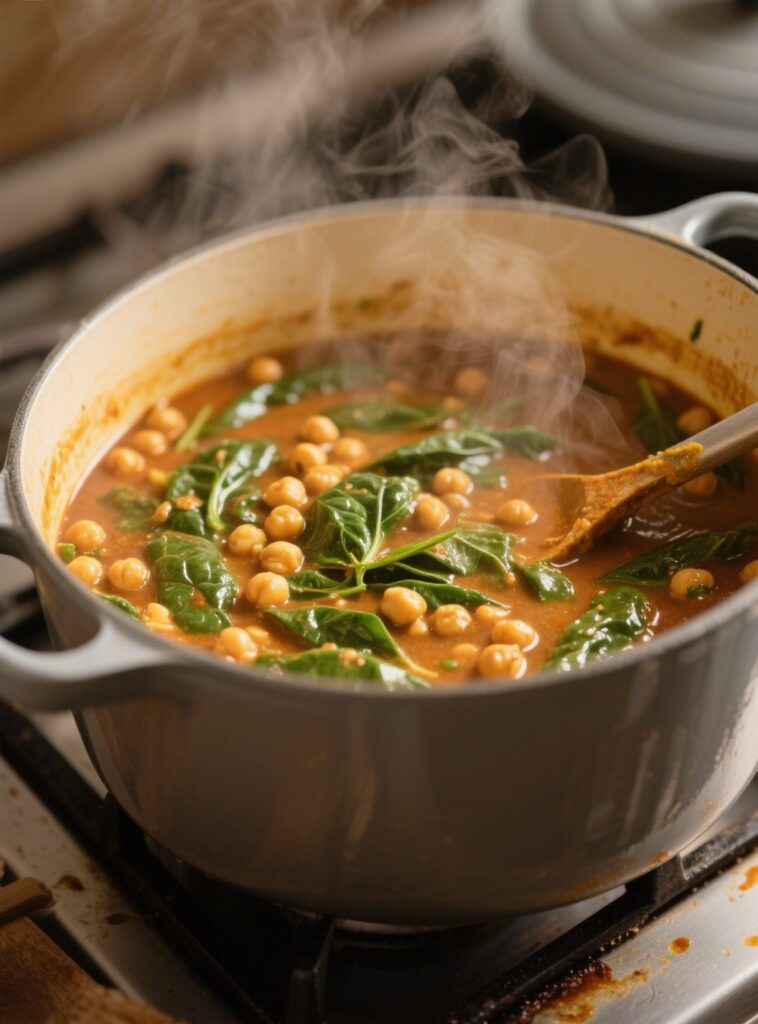
Simmering the Curry and Adding Spinach at the Right Time
Once your base is ready, the rest of the cooking process is smooth and forgiving. Here’s how to finish your chickpea spinach curry:
- Add Coconut Milk, Chickpeas, and Broth
Pour in the coconut milk, chickpeas (rinsed and drained), and vegetable broth. Stir well to combine, then bring the mixture to a gentle boil. The coconut milk will add creaminess and help balance the acidity of the tomatoes. - Simmer Gently (Uncovered)
Reduce the heat and let the curry simmer uncovered for about 15 minutes. Stir occasionally to prevent sticking. Letting it simmer uncovered allows the sauce to thicken naturally. - Fold in the Spinach
Add the baby spinach just a few minutes before serving. Stir it in until wilted. Spinach cooks fast, and overcooking can make it soggy and dull in flavor. - Final Touches
Taste and adjust with salt if needed. A squeeze of lime juice or a sprinkle of fresh cilantro adds a fresh contrast that brightens the dish.
Don’t miss our puff pastry vegetable pot pie if you enjoy creamy, veggie-packed comfort meals.
With minimal effort, you’ll have a steaming pot of flavorful, protein-packed curry that’s perfect for serving with naan or rice.
Best Coconut Milk for Chickpea Spinach Curry
What Type of Coconut Milk Should You Use?
Coconut milk is the backbone of a well-balanced chickpea spinach curry. It adds creaminess, subtle sweetness, and rounds out the spice profile of the dish. But not all coconut milks are created equal.
Here’s how to choose the right kind:
- Go for Full-Fat Canned Coconut Milk
Full-fat coconut milk is thicker and creamier than its light or carton counterparts. It helps the curry cling to the chickpeas and creates that rich, velvety mouthfeel you want in a good curry. - Avoid Sweetened or Flavored Options
Some coconut milk brands, especially those in cartons, come with added sweeteners or vanilla flavoring—avoid these. You want a neutral, savory coconut milk that won’t compete with your spices. - Shake It Up
If your canned coconut milk has separated (cream on top, water on bottom), just shake it well before opening. Or stir it together in a bowl before adding to the pot for even consistency. - Brands to Consider
Some trusted brands include Thai Kitchen, Native Forest, and Aroy-D. These tend to offer consistent quality and a naturally rich coconut taste.
The coconut milk you choose can make or break the balance of your curry, so don’t skimp on quality here.
Canned vs. Carton Coconut Milk: Which Works Best?
Let’s break down the difference between canned coconut milk and carton coconut milk to help you make the best decision for your chickpea spinach curry:
| Feature | Canned Coconut Milk | Carton Coconut Milk |
|---|---|---|
| Fat Content | High (17–22%) | Low (5–7%) |
| Texture | Thick and creamy | Thin and watery |
| Cooking Suitability | Best for curries and soups | Better for smoothies or cereal |
| Additives | Minimal (in quality brands) | May contain stabilizers |
| Flavor | Rich, deep coconut taste | Mild coconut taste |
Verdict: Canned coconut milk is the clear winner when it comes to curry. It holds up better under heat and contributes to the thick, luscious texture that makes every bite satisfying.
If you’re trying to cut calories, light canned coconut milk is a decent compromise—but keep in mind that it may not be as flavorful or creamy.
Looking for inspiration? Try quick vegetarian black bean enchiladas for another easy dinner idea with pantry staples.
Customizing the Chickpea Spinach Curry
Adding Other Proteins: Tofu, Tempeh, or Lentils
While chickpeas are the heart of a classic chickpea spinach curry, you can definitely mix things up if you’re craving variety or need a protein boost.
Here are some flavorful, plant-based swaps and additions:
- Tofu
Firm or extra-firm tofu absorbs flavor well and holds up during cooking. For best results, press the tofu first to remove excess water, cube it, and pan-fry until golden before adding it to the curry during the simmering stage. - Tempeh
For a nuttier, more textured protein, tempeh is a fantastic alternative. Steam or marinate it briefly to cut bitterness, then add it in just like tofu. - Red Lentils
Split red lentils cook quickly and add a creamy texture to the curry. Add ½ cup of dry lentils along with the tomatoes and broth. They’ll cook down during the 15-minute simmer and blend right in with the chickpeas. - White Beans or Black Beans
If you’re out of chickpeas, white beans or black beans can be a great substitute. They won’t have the same nutty flavor, but they bring the same protein and fiber punch.
Using other proteins keeps the dish plant-based and allows you to get creative with what’s in your pantry.
Boosting the Vegetable Content with Seasonal Additions
This chickpea spinach curry is the perfect base for loading up on vegetables—fresh, frozen, or even leftovers. Not only does it enhance the nutritional value, but it adds texture, color, and flavor.
Here are some great add-in ideas:
- Cauliflower or Broccoli
These work beautifully in curry. Chop into small florets and add at the same time as the chickpeas so they have time to soften. - Sweet Potatoes or Butternut Squash
These root vegetables bring a natural sweetness that balances the spice. Dice and pre-cook slightly or add them early in the simmer stage to ensure they’re tender. - Zucchini or Bell Peppers
Stir them in during the last 5 minutes of simmering to keep them from getting mushy. They add a fresh, summery note. - Frozen Mixed Veggies
In a pinch? Add a cup of frozen vegetables straight from the freezer. They’ll heat through and blend right in.
Learn more about easy homemade tomato soup with grilled cheese croutons if you want a simple plant-forward starter to serve alongside your curry.
Adding a mix of vegetables makes the curry more colorful, hearty, and nutritious—all without needing extra cooking time.
Making It Vegan and Allergy-Friendly
How to Keep It 100% Vegan
The good news? Chickpea spinach curry is naturally vegan when prepared with plant-based ingredients. Still, it’s helpful to double-check a few key points to ensure you’re sticking to a fully plant-based dish:
- Use Vegetable Broth
Skip chicken broth—stick to a flavorful vegetable broth or stock to keep it plant-based. - Coconut Milk Is Your Creamy Friend
Avoid any dairy-based cream or yogurt. Full-fat coconut milk delivers all the creaminess you need without any animal products. - Serve with Vegan Sides
Be sure to pair with vegan-friendly sides. Rice, quinoa, and store-bought or homemade vegan naan are excellent options. Some packaged naan contains yogurt or milk, so check the label. - Use Vegan Garnishes
Top with chopped cilantro, lime wedges, or even a scoop of dairy-free yogurt made from cashews or soy for added richness.
No eggs, cheese, or butter required. This recipe is a staple for plant-based eaters because it requires zero substitutions to be completely vegan from the start.
Substitutes for Common Allergens (Gluten, Soy)
In addition to being vegan, this chickpea spinach curry can easily be made allergy-friendly to suit various dietary restrictions:
- Gluten-Free
All the core ingredients—chickpeas, coconut milk, spinach, and spices—are naturally gluten-free. Just make sure your broth and canned goods are certified gluten-free (some brands add wheat-based thickeners). Serve with gluten-free grains like jasmine rice or brown rice instead of traditional naan. - Soy-Free
This dish is already soy-free, assuming you don’t use tofu or soy-based yogurt as toppings. If you need to add protein without soy, go with lentils or more vegetables. - Nut-Free
Although coconut is technically a drupe, not a nut, some with nut allergies still avoid it. If needed, swap coconut milk for oat cream or rice milk thickened with a touch of cornstarch or blended cashews (if safe). - Low-Sodium
Use low-sodium canned chickpeas and tomatoes, and opt for unsalted vegetable broth. You can always add a touch of salt at the end to control flavor.
The versatility of this curry is what makes it so appealing. With just a few small adjustments, it can accommodate almost any diet or preference.
Check out creamy avocado pasta salad for potlucks for another allergy-conscious, plant-forward dish that’s perfect for sharing.
Pairing and Serving Ideas for Chickpea Spinach Curry
Best Side Dishes: Rice, Naan, or Quinoa
The bold flavors and creamy texture of chickpea spinach curry deserve the right sidekick. Whether you’re looking for something traditional or experimenting with new textures, these options pair beautifully:
1. Steamed Basmati or Jasmine Rice
Classic, fragrant, and soft—rice is the ultimate pairing. Basmati rice complements Indian-style curries with its light, fluffy grains and subtle aroma. Jasmine rice works well too if you prefer something slightly stickier.
2. Homemade or Store-Bought Naan
If you’re going for comfort, naan is a must. Warm, chewy naan is perfect for scooping up curry and soaking up all that creamy coconut sauce. You can even try garlic naan or chili naan for an extra flavor boost.
Tip: For a vegan option, check that the naan is dairy-free or make your own with flour, plant-based yogurt, and baking powder.
3. Quinoa or Brown Rice
Looking for a protein boost? Quinoa is a great gluten-free grain that adds a nutty texture and extra amino acids. Brown rice, with its fiber-rich profile, makes the meal more filling and hearty.
4. Cauliflower Rice (Low-Carb Option)
For those reducing carbs, cauliflower rice is a light and nutrient-packed alternative that soaks up curry just as well as rice without the heaviness.
No matter your dietary preference, there’s a side dish that works seamlessly with this curry to round out your plate.
Garnishing Tips for Extra Flavor and Texture
Garnishes aren’t just decorative—they add texture, brightness, and depth to every bite of your chickpea spinach curry. Here’s how to level up your presentation and flavor:
- Fresh Cilantro (Coriander Leaves)
A handful of chopped cilantro adds a pop of green and a burst of citrusy freshness. Add it right before serving to keep the flavor vibrant. - Squeeze of Lime or Lemon
A dash of acidity brightens the entire dish and balances the creaminess of the coconut milk. Serve lime wedges on the side for your guests to add as they please. - Toasted Coconut Flakes or Cashews
For texture, sprinkle some toasted coconut flakes or chopped cashews on top. This adds a delightful crunch that contrasts the soft chickpeas. - Dollop of Vegan Yogurt
If you like it creamy with a little tang, a spoon of unsweetened vegan yogurt adds a cooling element and creaminess. - Red Chili Flakes or Fresh Sliced Chilies
Want more heat? Top it off with a few chili flakes or thin slices of fresh red chili.
Pairing and garnishing your curry thoughtfully doesn’t just elevate taste—it enhances the entire dining experience.
Storage, Meal Prep, and Reheating
How to Store and Freeze Leftovers
One of the best things about chickpea spinach curry is how well it holds up for leftovers. In fact, the flavors deepen overnight, making it even more satisfying the next day.
Here’s how to store it properly:
Refrigeration
- Cool it completely before storing to avoid condensation and bacterial growth.
- Transfer to an airtight glass or BPA-free plastic container.
- It stays fresh in the fridge for up to 5 days.
Freezing
- This curry freezes beautifully, especially if you leave out the spinach and add it fresh when reheating.
- Portion the curry into freezer-safe containers or resealable bags (lay them flat for space-saving storage).
- It will last up to 3 months in the freezer.
Important Tip:
Avoid storing it with rice or naan in the same container. Keep sides separate to prevent sogginess and texture breakdown.
Reheating Tips to Maintain Taste and Texture
Reheating chickpea spinach curry is easy, but there are a few tricks to ensure it tastes just as good as it did fresh:
Stovetop Method (Best for Flavor)
- Pour the curry into a saucepan.
- Heat over medium-low, stirring occasionally.
- Add a splash of water or broth if the sauce has thickened too much in the fridge.
This method is ideal for restoring moisture and preventing overcooking the spinach.
Microwave Method (Quickest)
- Place a portion in a microwave-safe dish and cover loosely.
- Heat on high for 60–90 seconds, stir, then heat for another 30 seconds if needed.
- Again, add a tablespoon of water or broth if it looks too thick.
Freezer Reheat
- Thaw overnight in the fridge or defrost gently in the microwave before reheating fully.
By using these techniques, you’ll maintain that rich coconut flavor and soft-but-not-mushy texture in every bite.
Don’t miss our chickpea spinach curry reheating tips and original recipe for reference any time you prep ahead!
Common Mistakes to Avoid
Overcooking the Spinach or Spices
Even though chickpea spinach curry is a forgiving recipe, there are a few mistakes that can compromise the final result—especially when it comes to timing and heat.
Mistake #1: Adding Spinach Too Early
Spinach is delicate and cooks in under 2 minutes. If added too early, it becomes overly soft and loses its vibrant color and nutritional value.
Fix it: Add spinach during the final 2–3 minutes of cooking—just enough time for it to wilt.
Mistake #2: Burning the Spices
Sautéing spices too long or on high heat can make them taste bitter and harsh.
Fix it: Toast spices for no more than 60 seconds on medium heat, stirring constantly to avoid burning the garlic.
Mistake #3: Not Using Enough Oil
A common shortcut is cutting back too much on oil. Without enough oil, the spices can dry out and clump instead of blooming.
Fix it: Stick to the recipe amount (1 tbsp) for sautéing onions and spices to bring out full aroma and depth.
Making It Too Watery or Too Thick
Coconut milk-based curries walk a fine line—too much liquid, and it’s soupy; too little, and it can turn into a paste. Here’s how to balance the texture:
Mistake #4: Skipping the Simmer
Simmering allows the sauce to thicken naturally and blend the spices. If skipped or rushed, the curry can taste flat and feel watery.
Fix it: Always simmer for at least 15 minutes uncovered.
Mistake #5: Using Light Coconut Milk Without Adjustments
Light coconut milk has more water content and can lead to a thinner curry if you don’t adjust for it.
Fix it: If using light coconut milk, reduce broth or simmer longer to reach the right consistency.
Mistake #6: Not Tasting and Adjusting
Every canned product has slight flavor variations. Not adjusting for salt, spice, or acidity can leave the curry unbalanced.
Fix it: Taste before serving and adjust salt, lime juice, or chili to match your preference.
Avoiding these mistakes ensures a chickpea spinach curry that’s flavorful, balanced, and restaurant-quality every single time.
Frequently Asked Questions
What is the best kind of coconut milk to use?
For the richest, creamiest results, always use full-fat canned coconut milk. It adds the right balance of texture and flavor without watering down the dish. Avoid sweetened or carton-style coconut milk, as they often contain additives or are too thin for curries.
Tip: Brands like Aroy-D or Thai Kitchen offer consistent quality. Always shake the can or stir before use to blend the cream and liquid.
Can you use a different protein besides the chickpeas?
Absolutely. While chickpeas are traditional in this chickpea spinach curry, you can swap or supplement with:
Tofu (firm, pan-fried)
Tempeh (steamed or sautéed)
Lentils (especially red or yellow lentils)
White or black beans
These proteins maintain the curry’s plant-based benefits while adding variety to your weekly meal plan.
How could I add more vegetables to this?
This curry is incredibly versatile and pairs well with nearly any vegetable. Here are some popular choices:
Cauliflower florets
Sweet potato cubes
Zucchini slices
Bell peppers or peas
Frozen mixed vegetables
Add firm vegetables during the simmer stage, and stir in delicate veggies (like peas or zucchini) in the last 5 minutes for perfect texture.
Can I make this vegan?
Yes—and the best part is, this recipe is already vegan by default. It uses plant-based ingredients like chickpeas, spinach, vegetable broth, and coconut milk. To ensure everything stays vegan:
Use certified vegan naan or rice as a side
Avoid any dairy garnishes
Double-check spice blends and broth labels for animal products
This makes chickpea spinach curry one of the easiest go-to recipes for those on a plant-based diet.
Conclusion
There’s a reason chickpea spinach curry is a favorite in kitchens around the world—it’s rich, comforting, and unbelievably easy to make. Whether you’re a busy home cook looking for a nourishing weeknight meal or a plant-based foodie wanting to spice things up, this curry checks every box.
With just a few pantry staples, you can whip up a dish that’s not only delicious but packed with fiber, protein, and vibrant flavors. Plus, it’s endlessly customizable—add veggies, change the protein, or play with spices to match your taste.
Ready to add another go-to dinner to your rotation? Make a double batch. You’ll thank yourself later.
Looking for inspiration? Try creamy avocado pasta salad for another delicious, plant-forward meal that complements curry night perfectly.
Print
Chickpea Spinach Curry
- Total Time: 30 min
- Yield: 2 1x
- Diet: Vegetarian
Description
A hearty, vegan chickpea spinach curry that’s rich, spicy, and perfect for a 30-minute weeknight dinne
Ingredients
1 tablespoon olive oil
1 medium yellow onion, diced
3 garlic cloves, crushed or finely minced
1 tablespoon garam masala
2 teaspoons ground coriander
1½ teaspoons ground turmeric
1 can (400ml / 15 oz) crushed tomatoes
1 can (400ml / 13.5 oz) full-fat coconut milk
1½ cans (410ml / 15 oz each) chickpeas, rinsed and drained (about 2 cups)
¼ cup vegetable broth or stock (low-sodium preferred)
2 tightly packed cups baby spinach (about 90g)
Sea salt to taste
Optional garnish: Fresh cilantro, lime wedges, dairy-free yogurt
Instructions
- Sauté the Aromatics
Heat the olive oil in a large pot over medium heat. Add the diced onion and sauté for 4–5 minutes until translucent. - Bloom the Spices
Add crushed garlic, garam masala, coriander, and turmeric. Stir constantly for 1 minute until the spices are fragrant. - Deglaze and Combine
Pour in crushed tomatoes, coconut milk, chickpeas, and vegetable broth. Mix well and bring to a gentle boil. - Simmer to Thicken
Reduce heat and simmer uncovered for 15 minutes, stirring occasionally. This reduces excess liquid and enhances the flavor. - Add Spinach
Stir in the baby spinach until just wilted—about 2 minutes. - Season & Serve
Add salt to taste and serve hot with rice, naan, or your favorite grain. Garnish with cilantro and lime juice for extra brightness.
Notes
Simmer uncovered to reduce excess moisture and thicken the curry naturally
For extra protein, add red lentils or cubed tofu
Prefer a spicier version? Add fresh green chili or a pinch of cayenne with the spices
Don’t skip the lime juice—it brightens the dish beautifully right before serving
- Prep Time: 10 min
- Cook Time: 20 min
- Category: Vegetarian
- Cuisine: Indian-Inspired, Vegan
Nutrition
- Calories: ~350 kcal
- Sugar: 5g
- Sodium: 350mg
- Fat: 16g
- Saturated Fat: 8g
- Carbohydrates: 38g
- Fiber: 10g
- Protein: 12g

